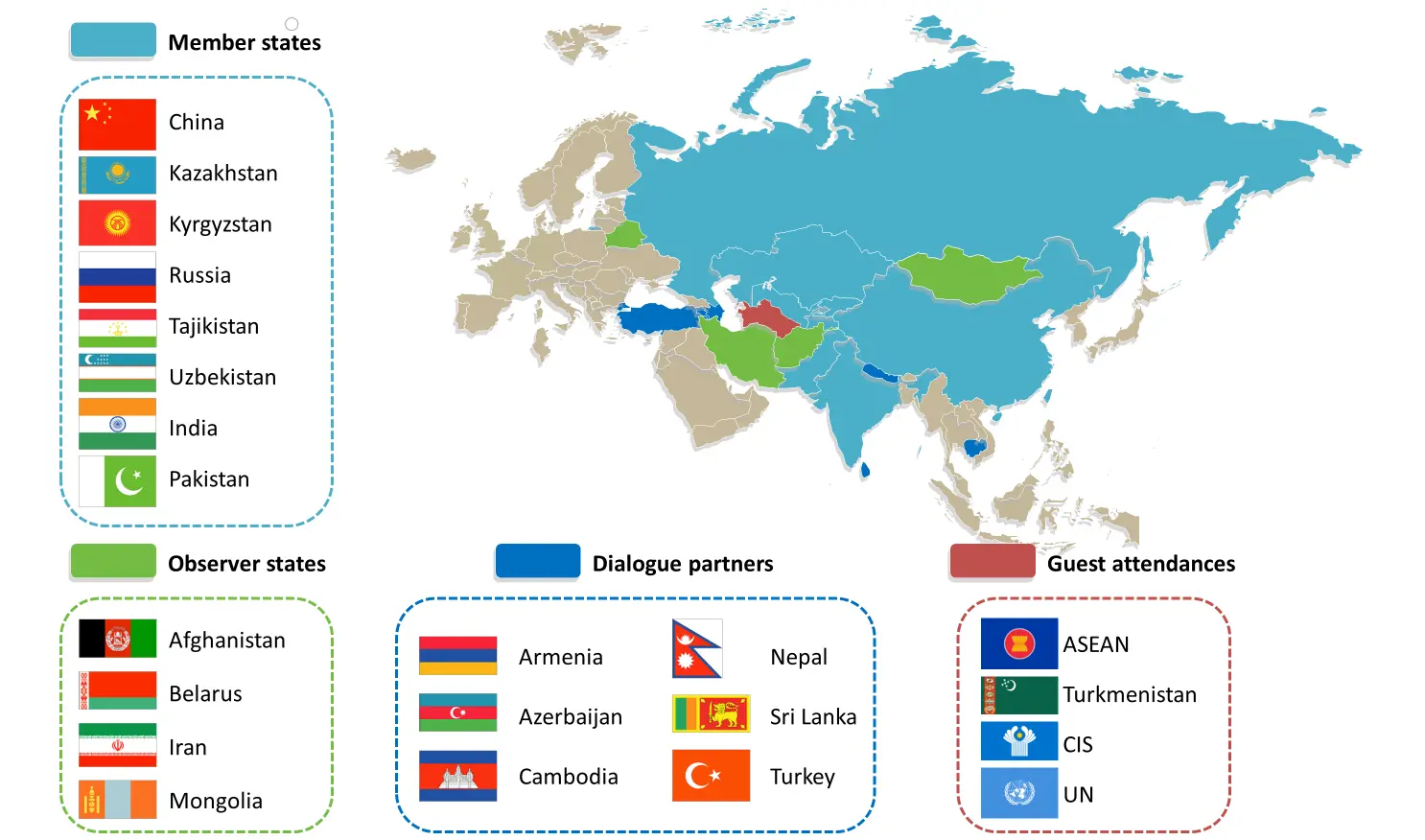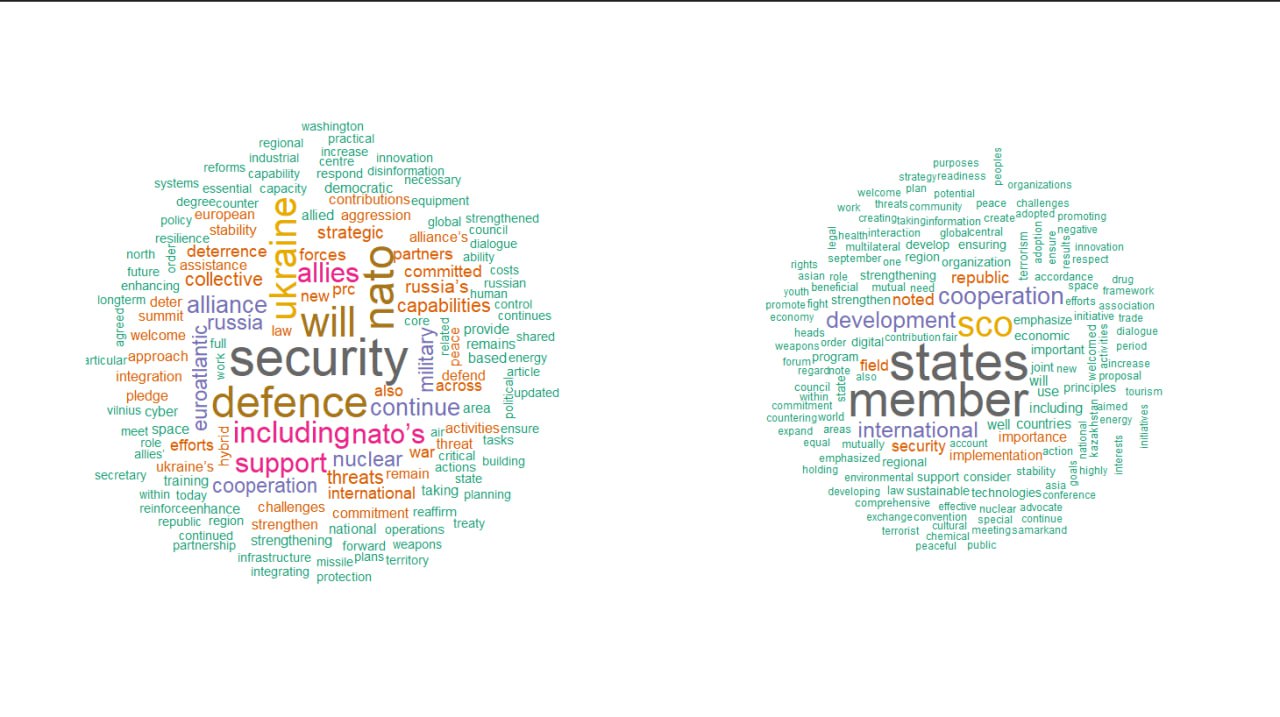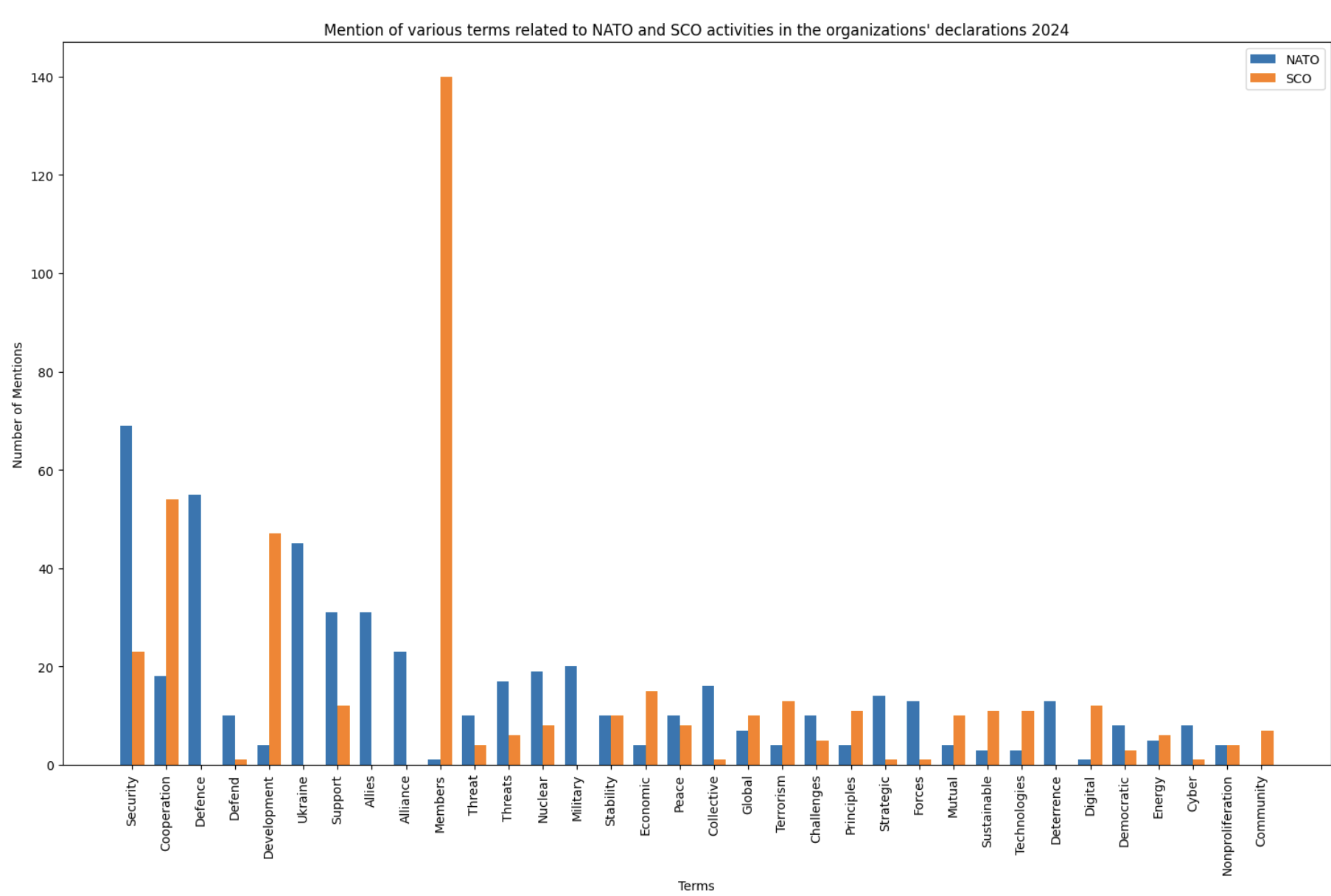Washington vs Astana: comparison of the NATO and SCO declarations
The North Atlantic Treaty Organization (NATO) and the Shanghai Cooperation Organization (SCO) are two significant international organizations that play pivotal roles in global geopolitics. NATO, established in 1949, is a military alliance of primarily Western countries committed to mutual defense and security. It aims to ensure the freedom and security of its member states through political and military means, with a strong emphasis on collective defense as outlined in Article 5 of the Washington Treaty. NATO’s influence extends beyond its member states, often involving itself in global security issues, crisis management, and cooperative security.
On the other hand, the SCO, founded in 2001, primarily includes countries from Eurasia, focusing on political, economic, and security-related cooperation. The organization promotes regional stability, counterterrorism, and economic development among its member states. The SCO emphasizes non-interference in internal affairs, respect for sovereignty, and mutual benefit, fostering a multipolar world order. It aims to counterbalance Western influence and provide a platform for member states to address regional issues collaboratively.

The NATO Washington Summit 2024 marked the 75th anniversary of the alliance on July 9-11, 2024. Key discussions focused on the strategic realignment in response to the ongoing conflict in Ukraine, NATO’s expansion, and increased defense spending among member nations.
The SCO Summit in Astana on July 4, 2024 centered on regional cooperation, political stability, and economic development. On this day Belarus became a member of the organization.
At the end of both events, declarations were adopted: the Washington Declaration for NATO and the Astana Declaration for the SCO. Both documents outline the plans, areas of activity and principles of work of the organizations. The contents of both documents are compared in this article.
Relevance of Comparing NATO and SCO Declarations
Comparing the declarations from NATO and SCO summits provides valuable insights into the strategic orientations, priorities, and geopolitical stances of these two major organizations. The declarations reflect their respective approaches to global security, international relations, and regional stability. By analyzing these documents, we can better understand the contrasting and sometimes converging narratives that shape the policies and actions of NATO and SCO member states.
This comparison is particularly relevant in the current geopolitical landscape, where tensions between major powers and regional conflicts are prevalent. The NATO declaration, for example, underscores a strong commitment to collective defense, democratic values, and countering threats from specific countries like Russia and China. In contrast, the SCO declaration focuses on promoting a multipolar world order, non-interference, and mutual respect among states.
By using R for text analysis, we can systematically analyze the language, themes, and sentiment of the declarations, providing a data-driven perspective on the strategic narratives of NATO and the SCO. This approach not only enhances the rigor of the analysis but also offers visual insights through graphs and charts, making the comparison more accessible and compelling for readers.
Strategic Focus and Orientation: for the NATO – common security, for the SCO – cooperation among members
The NATO declaration emphasizes collective defense and security, particularly in response to perceived threats from Russia and terrorism. It highlights the importance of the transatlantic bond and the integration of new member states such as Sweden and Finland. The declaration focuses on deterrence, defense, crisis prevention, and cooperative security while stressing adherence to democratic values, human rights, and the rule of law. NATO also concentrates on strengthening military capabilities and readiness, including nuclear and missile defense, and integrating advanced technologies.
In contrast, the SCO declaration emphasizes the creation of a multipolar world order and strengthening global peace, security, and stability. It advocates for non-interference in internal affairs, respect for sovereignty, and mutual benefit. The declaration stresses the importance of economic cooperation, cultural ties, and environmental sustainability. The SCO focuses on combating terrorism, separatism, and extremism, along with drug trafficking and organized crime. It highlights regional stability, particularly in Central Asia, and promotes cooperation in various fields, including the digital economy, agriculture, and energy security.
This is demonstrated quite vividly by wordclouds that have been plotted through the R programming language.

Key Themes and Priorities
As a result of defining the terms that appear most frequently in the texts of both declarations, it is possible to identify the themes that are most emphasized. NATO’s declarations emphasize security, defence, military readiness, and support for Ukraine and allies, reflecting its traditional role as a security alliance. In contrast, the SCO focuses more on cooperation, development, and economic aspects, with significant attention to terrorism, principles, and sustainability. Both organizations recognize global challenges and the importance of emerging technologies, but their approaches and priorities differ markedly.
NATO places a significant emphasis on security, with 69 mentions, indicating its commitment to ensuring member states’ safety and addressing various security threats. In contrast, the SCO highlights cooperation, with 54 mentions, suggesting a strong emphasis on collaborative efforts among member states.
Regarding defence and military, NATO mentions defence 55 times and military 20 times, underlining its role in collective defense and military readiness. Conversely, the SCO has no mentions of defence or military, which may indicate a different approach or less emphasis on military aspects compared to NATO.

In terms of development and economic focus, NATO has only 4 mentions of development, reflecting a lesser focus on development activities within the NATO framework. The SCO, on the other hand, prominently mentions development 47 times, highlighting a significant focus on economic and developmental cooperation among its member states.
Ukraine and allies are key terms for NATO, with 45 and 54 mentions respectively, reflecting NATO’s support for Ukraine amid ongoing conflicts and the importance of alliance solidarity. The SCO does not mention Ukraine or allies, indicating these terms are not central to its current narrative.
Both organizations address threats and stability, with NATO mentioning threat 27 times and stability 10 times, indicating ongoing security concerns and efforts to maintain regional stability. The SCO mentions threat 10 times and stability also 10 times, showing a balanced approach to these issues.
NATO’s focus on global security and collective defense mechanisms is evident from the 7 mentions of global and 16 mentions of collective. The SCO, however, mentions global 10 times and collective only once, indicating a slightly more global perspective but less emphasis on collective actions compared to NATO.
Terrorism and challenges are ongoing concerns for NATO, with 4 mentions of terrorism and 10 mentions of challenges. The SCO places more emphasis on terrorism with 13 mentions, reflecting a significant focus on counter-terrorism efforts, while challenges are mentioned 5 times, indicating recognition of various difficulties.
NATO’s commitment to core values and long-term strategic planning is shown through 4 mentions of principles and 14 mentions of strategic. The SCO discusses principles more frequently, with 11 mentions, suggesting a strong emphasis on foundational values, while strategic is mentioned only once.
Emerging technologies and sustainability receive some attention from NATO, with 3 mentions each of technologies and sustainable, but they are not primary focuses. The SCO, however, significantly mentions technologies 11 times and sustainable 11 times, indicating a strong emphasis on technological advancements and sustainability initiatives.
In terms of cyber and digital transformation, NATO mentions cyber 8 times and digital once, reflecting concerns about cybersecurity and digital transformation. The SCO has less focus on cyber with only 1 mention, but places a strong emphasis on digital transformation with 12 mentions.
NATO’s declaration places a strong emphasis on collective defense, underscoring Article 5 of the Washington Treaty and the commitment to defend each other. There is an extensive focus on the threat posed by Russia, the military conflict in Ukraine, and support for Ukraine’s defense. The declaration also emphasizes the modernization of defense capabilities, increased defense spending, and large-scale military exercises. Additionally, NATO highlights the adoption of new technologies, including AI, cyber defense, and space capabilities, while maintaining and modernizing nuclear capabilities as a cornerstone of security.
The SCO declaration advocates for a more representative, democratic, and multipolar world order, emphasizing the principles of sovereignty, territorial integrity, and non-interference. It focuses on stability and development in Central Asia and broader Eurasia, with coordinated efforts against terrorism, separatism, extremism, and organized crime. The declaration promotes economic cooperation, cultural exchanges, and environmental protection as key areas of collaboration among member states.
Geopolitical Context: detailed breakdown
NATO’s declaration identifies Russia as the most significant and direct threat, with concerns about China’s policies and its partnership with Russia. It addresses strategic competition, instability in Africa and the Middle East, and threats from hybrid and cyber activities. NATO also emphasizes strengthening ties with global partners like the EU, Australia, Japan, and others to address common security challenges.
Washington NATO Summit Declaration: “Russia remains the most significant and direct threat to Allies’ security.”
Washington NATO Summit Declaration: “The People’s Republic of China’s (PRC) stated ambitions and coercive policies continue to challenge our interests, security and values.”
The SCO declaration recognizes tectonic shifts in world politics and the emergence of a more just and multipolar world order. It calls for comprehensive UN reform to enhance the representation of developing countries. The SCO promotes joint efforts in various fields, including the economy, technology, environmental protection, and cultural exchanges, reflecting a collaborative approach to addressing global challenges.
Astana SCO Summit Declaration: “The use of force is intensifying, international law is being systematically violated, geopolitical confrontation and conflicts are growing, and risks to stability in the world and the SCO region are multiplying.”
Astana SCO Summit Declaration: “Member States emphasize the key role of the UN in countering threats in the information space, creating a safe information space built on the principles of respect for state sovereignty and non-interference in the internal affairs of other countries.”
Terroristic threat:
Both NATO and SCO emphasize the threats from terrorism, cyber threats, and geopolitical instability.
Washington NATO Summit Declaration: “Terrorism, in all its forms and manifestations, is the most direct asymmetric threat to the security of our citizens and to international peace and prosperity. “
Astana SCO Summit Declaration: “Member States emphasize that double standards are unacceptable in the fight against terrorism. Terrorism in any form and manifestation cannot be justified; condoning and harboring terrorists must be resolutely condemned by the entire world community.”
Hybrid threats:
NATO faces hybrid, cyber, space, and other threats from state and non-state actors. The declaration emphasizes the need “to prepare for, deter, defend against, and counter these hybrid threats”, including through the establishment of the NATO Integrated Cyber Defence Centre. This centre aims to enhance network protection, situational awareness, and the implementation of cyberspace as an operational domain. Additionally, NATO stresses the importance of developing capacity to analyze and counter hostile disinformation and misinformation operations.
Cyber threats are also a concern for the SCO, with efforts focused on countering cyber propaganda and disinformation campaigns by international terrorist organizations. The SCO emphasizes the key role of the UN in creating a safe information space based on respect for state sovereignty and non-interference in internal affairs.
Washington NATO Summit Declaration: “Establishing the NATO Integrated Cyber Defence Centre to enhance network protection, situational awareness, and the implementation of cyberspace as an operational domain throughout peacetime, crisis and conflict.”
Astana SCO Summit Declaration: “They will counter cyber propaganda and disinformation campaigns against SCO Member States carried out by international terrorist organizations.”
Nuclear Weapons and Nonprolifiration Regime
The NATO declaration emphasizes the importance of nuclear deterrence as a cornerstone of Alliance security. It outlines the need for a credible and effective nuclear capability to preserve peace, prevent coercion, and deter aggression. The declaration also highlights concerns about Russia’s irresponsible nuclear rhetoric and its actions in Belarus, which are seen as strategic intimidation. Additionally, NATO remains committed to its nuclear capabilities as long as nuclear weapons exist and stresses the importance of compliance with arms control agreements to ensure strategic stability.
The SCO declaration focuses on the importance of nuclear non-proliferation and the strict compliance with relevant treaties. It advocates for the early entry into force of the Protocol on Security Assurances to the Treaty on a Nuclear Weapon-Free Zone in Central Asia and emphasizes the need for comprehensive and balanced promotion of the goals of the Treaty on the Non-Proliferation of Nuclear Weapons. The declaration also calls for cooperation in the peaceful use of atomic energy and stresses the importance of nuclear disarmament and the global non-proliferation regime.
Washington NATO Summit Declaration: “Nuclear deterrence is the cornerstone of Alliance security. The fundamental purpose of NATO’s nuclear capability is to preserve peace, prevent coercion and deter aggression.”
“As long as nuclear weapons exist, NATO will remain a nuclear alliance. “
Astana SCO Summit Declaration: “Member States believe that the early entry into force of the Protocol on Security Assurances to the Treaty on a Nuclear Weapon-Free Zone in Central Asia (New York, May 6, 2014) for all signatory states will make a significant contribution to ensuring regional security and strengthening the nuclear non-proliferation regime.”
NATO and SCO: Divergent Paths in Global Security and Cooperation
The comparative analysis of the NATO and SCO declarations reveals distinct strategic orientations and priorities shaped by their unique geopolitical contexts and foundational principles. NATO, with its long-standing emphasis on collective defense, prioritizes military readiness, deterrence, and the defense of democratic values against perceived threats, particularly from Russia and terrorism. Its focus remains firmly on security, technological advancements in defense, and maintaining a robust nuclear deterrent.
Conversely, the SCO champions a multipolar world order characterized by non-interference, respect for sovereignty, and mutual benefit. Its declarations underscore regional stability, economic cooperation, and combating terrorism and extremism within a framework of mutual respect and collaboration. The SCO’s approach reflects a broader emphasis on economic development, cultural ties, and environmental sustainability, aiming to balance Western influence and foster a cooperative regional order.
Both organizations recognize the critical importance of addressing emerging global challenges such as cyber threats, terrorism, and geopolitical instability. However, their strategies diverge significantly: NATO’s militaristic and defensive posture contrasts with the SCO’s cooperative and development-oriented stance.
Written by: Eldaniz Gusseinov
Eldaniz Gusseinov, is a Non-Resident Research Fellow at Haydar Aliyev Center for Eurasian Studies of the Ibn Haldun University, Istanbul.
